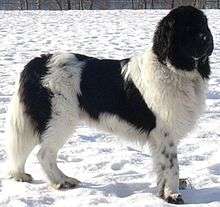Landseer (dog)
The term Landseer dog may refer to large black-and-white dogs of one of two dog breeds.
| Landseer Newfoundland | |||||||||||||||||||||
|---|---|---|---|---|---|---|---|---|---|---|---|---|---|---|---|---|---|---|---|---|---|
 | |||||||||||||||||||||
| Other names | Landseer | ||||||||||||||||||||
| Origin | Newfoundland (now part of Canada) | ||||||||||||||||||||
| Foundation stock | Newfoundland | ||||||||||||||||||||
| |||||||||||||||||||||
| |||||||||||||||||||||
| Dog (domestic dog) | |||||||||||||||||||||
| ECT Landseer | |||||||||||||||||||||
|---|---|---|---|---|---|---|---|---|---|---|---|---|---|---|---|---|---|---|---|---|---|
 | |||||||||||||||||||||
| Other names | Landseer, European Continental Type Landseer | ||||||||||||||||||||
| Origin | Germany and Switzerland | ||||||||||||||||||||
| Foundation stock | Newfoundland | ||||||||||||||||||||
| |||||||||||||||||||||
| |||||||||||||||||||||
| Dog (domestic dog) | |||||||||||||||||||||
The "Landseer Newfoundland" dog is a black-and-white colour variant of the Newfoundland dog. It arises from the expression of the recessive Piebald colour allele commonly found in the breed. As the piebald colouration is a recessive trait, a single litter can have both Landseer and solid-coloured puppies, depending on the genotype of the parents[1].
The other breed is the "ECT Landseer" or (equivalently) the "European Continental Type Landseer" dog. The "ECT Landseer" is of European origin, but is clearly descended from, and closely related to, the same ancestral stock as the modern Newfoundland dog. They are however, on average, taller, slimmer, and more energetic than the modern Newfoundland dog [2].
Both dog breeds descend from dogs found on the island of Newfoundland and exported to Europe in the early 1800s. It is believed that the original Newfoundland dogs were descended from water dogs and livestock guardian dogs brought to the island by Portuguese and Basque fishing vessels, with possible crosses to indigenous dogs.[3][4]
In the Victorian era black-and-white Newfoundland dogs were more popular than the solid black colouration, and they were the subject of a number of 19th century artists including Sydenham Edwards, Philip Reinagle and Samuel Jones, and most famously Edwin Landseer.[3][4]. In the 20th century the solid black colouration became more popular and supplanted the bi-coloured animals, so much so that in the 1930s a concerted effort was made to recreate the dogs seen in the paintings of Edwin Landseer. The efforts of these breeders resulted in the ECT Landseer breed.[3][4]. In 1976 a separate breed club was created for what is now known as the ECT Landseer in Germany, and the ECT Landseer now has separate Fédération Cynologique Internationale recognition.[3][4]
_-_Lion-_A_Newfoundland_Dog_-_Google_Art_Project.jpg)
References
| Wikimedia Commons has media related to Landseer. |
- Schmutz, S. M.; Berryere, T. G. (December 2007). "Genes affecting coat color and pattern in domestic dogs: a review". Animal Genetics. 38 (6): 539–549. doi:10.1111/j.1365-2052.2007.01664.x. PMID 18052939. S2CID 28968274.
- https://www.dog-learn.com/dog-breeds/landseer/
- Fogle, Bruce (2009). The encyclopedia of the dog. New York: DK Publishing. p. 345. ISBN 978-0-7566-6004-8.
- Morris, Desmond (2001). Dogs:the ultimate guide to over 1,000 dog breeds. North Pomfret, VT: Trafalgar Square Publishing. p. 669. ISBN 1-57076-219-8.
